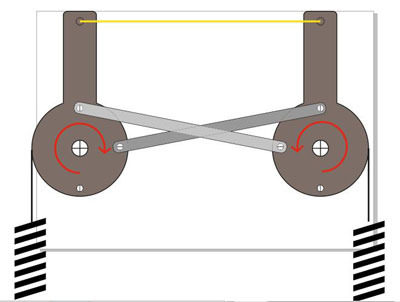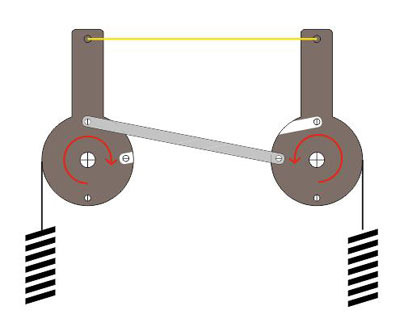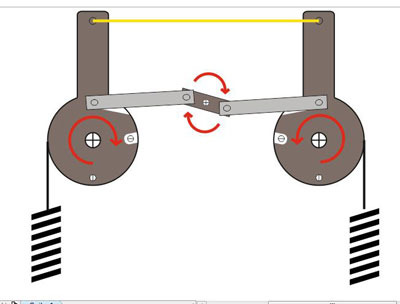Thats not good for accuracy. Maybe the error will be consistent so its no big deal? , but if not connected in some way a bit of sideways force on the tip of the limbs could move the central point of the string left/right easily if you dont care for consistent spanning etc.. I was wrapping my mind around how to synchronize the travel of the limbs in an easy way for this kind of device.
In regular compound crossbows this is achieved with cables but since the limbs are in fixed distance with no force between them cables are probably not the best solution.
you could make a cable system if you use frontal pulleys but the additional cables will add weight and will have travel all the way back and also be in the way of the strings travel path. Inswinger has a greatier string travel distance than regular crossbow so I dont think this is the best Idea.
I was thinking about linking the swing arms mechanically with fixed linkage bars.
Here is a drawing of what I am talking about, its not to scale,distance between limbs is too short, the linkage bars would have to be mounted somewhat under the swing arms as not to interfere with string travel, etc. etc. Its just a concept drawing of what I mean.

Maybe even a single linkage bar would be sufficient

A split linkage with central pivot has the disadvantage that if you put sideways force at the very tip of limbs it could shift left/right. so its not much better than without if you dont have the central pivot restrained in a groove so it can just slide up/down without side travel.

The downside of this (no1, No2) arrangement is that it gives only a 90° rotation at max. you want the string to take the stopping force so its even a bit less. This way the linkage bars dont have to take any great load and can be made from light material they are just there to even out any small difference in limb travel.
Any ideas of a linkage system that allows for 120° rotation which would be as easy to implement? using No3 with the central pivot restrained from left/right movement will do the trick but maybe there is other ideas I have not thought of?
I am still talking about individually powered limbs because this allows me to arrange the springs at the same plane as the limbs making for a direct force transfer.
A single spring under the stock would need redirection of force somehow, making for a more complicated build. I have thought about this also but construction would be more complicated for me with whats avaliable in terms of tools & materials.
If the end of the limbs is shaped like part of a circle (you dont need a full circle like shown here, its just ease of drawing) you will get consistent force from the spring throughout the whole travel of the limbs and angle of attack is always the same. I like this better than a straight bar for the limbs. I dont see a need for let-off in a crossbow. Springs dont have to point straight back, they can be fixed on the stock at one end, remember its just a concept drawing.
This is just what I came up with to adress the synchronizing of individually powered limbs, It may not be the best solution, just what came up first - I am open for different ideas. I dont want to do it with cables if I can avoid it - these will have to be tensioned somehow and also might stretch after some shooting, a fixed linkage of some kind seemed easier to me.
Maybe I am overcomplicating things, but limb synchronization seemed to be a good idea to me. There have been a number of "flipper" style builds but there have been no reports on accuracy/consistency of them. If I want to build one I would like it to be as accurate as possible and I know from compound crossbows that if the cables are out of sync the accuracy suffers...









 Private messages
Private messages